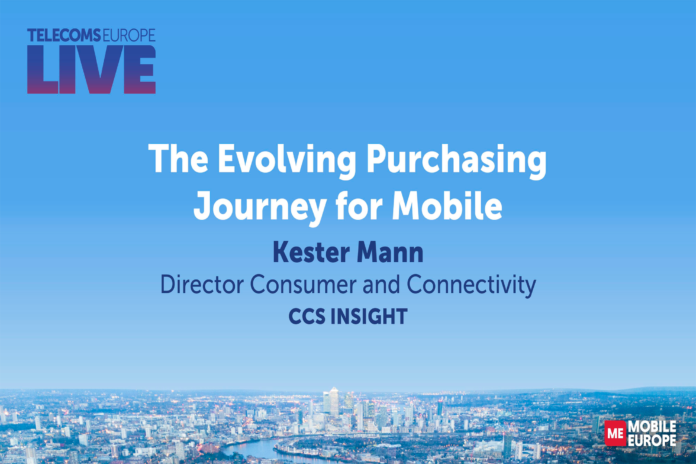At Telecom Europe LIVE, Kester Mann of CCS Insight presented some surprising findings about UK consumers
Kester Mann, Director Consumer and Connectivity, CCS Insight, looked at purchasing in UK – wanted to understand experiences and opinions of consumers with their mobile service provider.
A lively question and answer session followed with the audience. Watch the video here.
More than three-quarters – 78% of consumers who were surveyed owned either an Apple or Samsung device, which might be new or second hand. Apple has increased its share from 37% in 2019 to 46% in 2022 including some switching from Samsung. The smaller brands have not been able to capitalise on market share ceded by larger device makers such as Nokia and Huawei.
Cost of living crisis
CCS Insight probed how the cost of living crisis is shaping the attitudes of consumers regarding their telecoms and was surprised by the response. About 40% were planning or thinking about downgrading their package with their mobile or broadband provider.
Others intended to switch provider which could lead to higher levels of churn in a market with historically low levels of churn, and some intend to replace their phone sooner than they had planned. Mann said he thinks this is because they expect the price of devices to rise further and/or economic conditions to deteriorate.
Most UK service providers increase prices, including during contracts, in line with inflation every April, which this year meant rises of around 10%. Some providers, like Tesco Mobile and Sky Mobile do not raise prices during contracts. It seems consumers aren’t taking this lying down, with around 40% reacting to the rises: 16% negotiated a better deal with their provider; 14% moved to a cheaper plan and 8% switched supplier.
Folding stuff
Attitudes to foldable phones are encouraging, Mann noted. Samsung has been particularly active in advertising them. More than half find the idea of owning one appealing, and 46% they might or would consider purchasing one next time they upgrade their phones, although pricing was not discussed.
Currently they are more than £1,000 but Mann this could be a good source of growth if the prices come down. People like that they are compact and the bigger screen. Few cited their multi-tasking capabilities, suggesting manufacturers need to educate the market better. This was underlined by respondents who weren’t interested in foldable phones saying this is because they are largely satisfied with the devices they use. Another factor was price and others said they thought foldable phones were fragile.
Covid might be over but the buying online trend looks to be here to stay: in 2018, 47% of respondents bought their phones for personal use online, which rose to 55% 2022, with in-store sales down to 34%. Online purchasing was most popular with younger people.
It also turned out that people mostly research which phone they want online (37&) rather than visiting a store (17%) before making a purchase. In other words, people are seeing actual new phones and trying them out which should ring alarm bells with phone makers. About 20% didn’t even do any research before making their online purchase, particularly when buying Apple devices.
Interestingly, although the number of people visiting mobile phone shops appears to be falling, it is highest among younger people, probably because they have more time.
Refurb is growing
The refurbished phone market is small but well established, and rose from 4% in 2018 to 8% in 2022. Mann said CCS Insight expects this to grow for reasons including the ample supply of used phones, cost and purchases online. Under 16s were not included in the survey, but they are the biggest users of refurbished phones at up to 80%.
More than 22% of respondents said the reason they’d consider buying a used mobile phone is to help the environment, but 23% said they would want new devices. When asked what they would do to help the environment, 17% said they’d pay more for a sustainable mobile phone and 14% said they’d pay more to be with a mobile operator that does more the environment. In general, younger people are more enthusiastic about helping the planet than older people.
There are shifts in the packages people are buying, with 40% opting for SIM-only, up from 35% a year ago, due to attractive SIM offers and budget constraints.
Operator interactions
CCS Insight asked how do people expect to interact with their operator over the next six months? Three out of the top four options chosen by respondents were digital – a website, app or online chat. Good news for operators seeking to cut customer care and service costs through automation techniques, for instance, but it raises more questions about the future of stores.
Only 15% expected to visit such a shop in the next six months and 29% said they do not expect any interaction with their provider in that time.
Regarding operators’ apps, customers use them most to check bills and their usage, but also to look at loyalty schemes, browsing for phone and accessories: 9% said they intend to trade their phone in via an app. This is important for Vodafone in particular which want to digitise the part-exchange of mobile phones for upgrades.
A lively question and answer session followed with the audience. Watch the video here.


